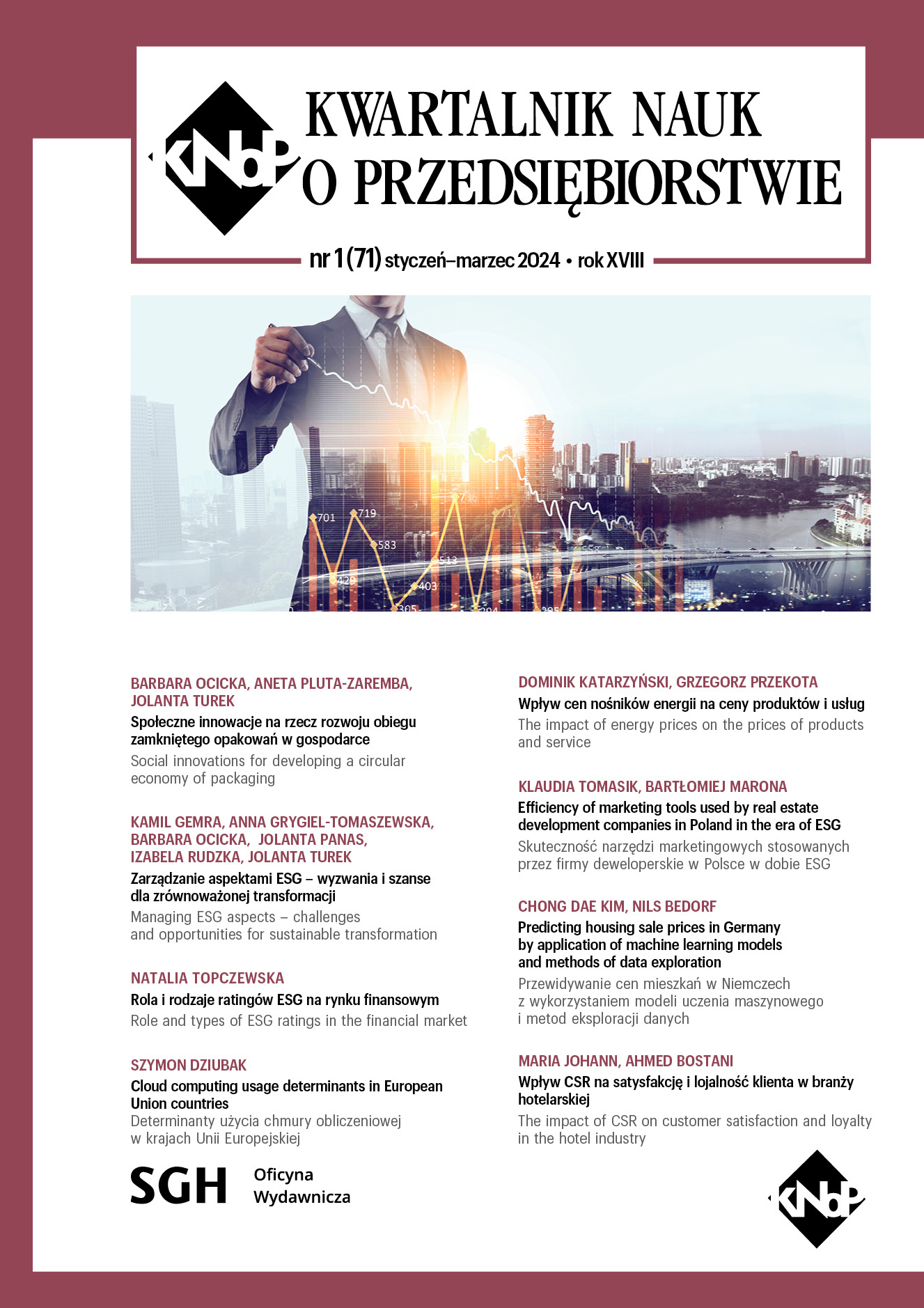Przewidywanie cen mieszkań w Niemczech z wykorzystaniem modeli uczenia maszynowego i metod eksploracji danych
Abstrakt
Przewidywanie cen nieruchomości jest popularnym problemem w dziedzinie uczenia maszynowego i często przedstawianym w literaturze. W przeciwieństwie do innych podejść, które koncentrują się na rynku amerykańskim, niniejszy artykuł bada największy niemiecki zbiór danych dotyczących nieruchomości, zawierający ponad 1,5 mln unikatowych próbek i ponad 20 cech. W tym artykule wdrażamy i porównujemy różne modele uczenia maszynowego pod względem wydajności i możliwości interpretacji, aby uzyskać wgląd w najważniejsze
Full Text
Bibliografia
Bedorf N. [2021], XAI–Modellagnostische Verfahren zur Erklärbarkeit von Machine Learning Algorithmen, mimeo.
Bundesamt für Justiz [2019], Federal Data Protection Act, https://www.gesetze-im-internet.de/englisch_bdsg/englisch_bdsg.html (accessed: 9.10.2021).
Chen T., Guestrin C. [2016], XGBoost: A Scalable Tree Boosting System, DOI: 10.1145/2939672.2939785.
Choi S. [2009], Performance evaluation of RANSAC family, British Machine Vision Conference, BMVC, London, UK, September 7–10, DOI: 10.5244/C.23.81.
Daniel S. [2021], Difference between RMSE and RMSLE, https://www.datascienceland.com/blog/difference-between-rmse-and-rmsle-656/ (accessed: 4.10.2021).
Empirica ag [2019], General Information, https://www.empirica-institut.de/thema/regionaldatenbank/datenbank-regionaldaten/ (accessed: 9.10.2021).
Fawcett A. [2021], Data Science in 5 Minutes: What is One Hot Encoding? https://www.educative.io/blog/one-hot-encoding (accessed: 22.09.2021).
Federal Statistical Office Germany [2021], Public datasets, https://www-genesis.destatis.de/genesis/online (accessed: 18.09.2021).
Géron A. [2019], Hands-On Machine Learning with Scikit-Learn, Keras, and TensorFlow, 2nd Edition – O’Reilly, ISBN: 9781492032649.
Gonzalez S., Garcia S., Del Ser J., Rokach L., Herrera F. [2020], A practical tutorial on bagging and boosting based ensembles for machine learning: Algorithms, software tools, performance study, practical perspectives and opportunities, DOI: https://doi.org/10.1016/j.inffus.2020.07.007.
He L., Zhang H. [2018], Kernel K-Means Sampling for Nyström Approximation, DOI:10.1109/TIP.2018.2796860.
Ke G., Meng Q., Finley T., Wang T., Chen W., Ma W., Ye Q., Liu T. [2017], LightGBM: A Highly
Efficient Gradient Boosting Decision Tree, NIPS.
Laerd Statistics [2021], Pearson correlation, https://statistics.laerd.com/statistical-guides/pearsoncorrelation-coefficient-statistical-guide.php (accessed: 12.09.2021).
Li L. [2018], CMU, Massively Parallel Hyperparameter Optimization, https://blog.ml.cmu.edu/2018/12/12/massively-parallel-hyperparameter-optimization/ (accessed: 2.10.2021).
Magiya J. [2019], Kendal Rank Correlation Explained, https://towardsdatascience.com/kendallrank-correlation-explained-dee01d99c535 (accessed: 20.09.2021).
OpenStreetMap contributors [2017], Planet dump, https://www.planet.osm.org (accessed: 9.10.2021).
Pargent F. [2021], Regularized target encoding outperforms traditional methods in supervised machine learning with high cardinality features, arXiv:2104.00629 [stat.ML].
Park B., Bae J. K. [2015], Using machine learning algorithms for housing price prediction: The case of Fairfax County, Virginia housing data, DOI: https://doi.org/10.1016/j.eswa.2014.11.040.
Pedregosa F., Varoquaux G., Gramfort A., Michel V., Thirion B., Grisel O., Blondel M., Prettenhofer P., Weiss R., Dubourg V., Vanderplas J., Passos A., Cournapeau D., Brucher M., Perrot M., Duchesnay E. [2011], Scikit-learn: Machine learning in Python, “Journal of Machine Learning Research”, no. 12 (Oct), pp. 2825–2830.
Pow N., Janulewicz E., Liu L. [2014], Applied Machine Learning Project 4 Prediction of real estate property prices in Montreal.
RUser4512 [2018], Computational complexity of machine learning algorithms, https://www.thekerneltrip.com/machine/learning/computational-complexity-learning-algorithms/ (accessed: 4.09.2021).
Seger C. [2018], KTH, EECS, An investigation of categorical variable encoding techniques in machine learning: binary versus one-hot and feature hashing, OAI:DiVA.org:kth-237426.
Shashanka M. [2019], What is a Pipeline in Machine Learning? How to create one? https://medium.com/analytics-vidhya/what-is-a-pipeline-in-machine-learning-how-to-create-one-bda91d-0ceaca (accessed: 14.09.2021).
The Economist [2017], On almost every indicator, Germany’s south is doing better than its north, https://www.economist.com/kaffeeklatsch/2017/08/20/on-almost-every-indicator-germanyssouth-is-doing-better-than-its-north (accessed: 25.09.2021).
Viktorovich P. A., Aleksandrovich P. V., Leopoldovich K. I., Vasilevna P. I. [2018], Predicting Sales Prices of the Houses Using Regression Methods of Machine Learning, DOI: 10.1109/RPC.2018.8482191.
Wu J. Y. [2017], Housing Price prediction Using Support Vector Regression, DOI: https://doi.org/10.31979/etd.vpub-6bgs.
Yang T., Li Y., Mahdavi M., Jin R., Zhou Z. [2012], Nystroem Method vs Random Fourier Features: A Theoretical and Empirical Comparison, Advances in Neural Information Processing Systems.
Yeo I. K., Johnson R. A. [2000], A new family of power transformations to improve normality or symmetry, “Biometrika”, vol. 87 (4), pp. 954–959.
Zhang C., Ma Y. [2012], Ensemble Machine Learning, Methods and Applications, Springer, ISBN: 978-1-4419-9326-7.
Autor
Prawa autorskie (c) 2024 Kwartalnik Nauk o Przedsiębiorstwie

Utwór dostępny jest na licencji Creative Commons Uznanie autorstwa 4.0 Międzynarodowe.
Autor (Autorzy) artykułu oświadcza, że przesłane opracowanie nie narusza praw autorskich osób trzecich. Wyraża zgodę na poddanie artykułu procedurze recenzji oraz dokonanie zmian redakcyjnych. Przenosi nieodpłatnie na Oficynę Wydawniczą SGH autorskie prawa majątkowe do utworu na polach eksploatacji wymienionych w art. 50 Ustawy z dnia 4 lutego 1994 r. o prawie autorskim i prawach pokrewnych – pod warunkiem, że praca została zaakceptowana do publikacji i opublikowana.
Oficyna Wydawnicza SGH posiada autorskie prawa majątkowe do wszystkich treści czasopisma. Zamieszczenie tekstu artykuły w repozytorium, na stronie domowej autora lub na innej stronie jest dozwolone o ile nie wiąże się z pozyskiwaniem korzyści majątkowych, a tekst wyposażony będzie w informacje źródłowe (w tym również tytuł, rok, numer i adres internetowy czasopisma).
Osoby zainteresowane komercyjnym wykorzystaniem zawartości czasopisma proszone są o kontakt z Redakcją.

